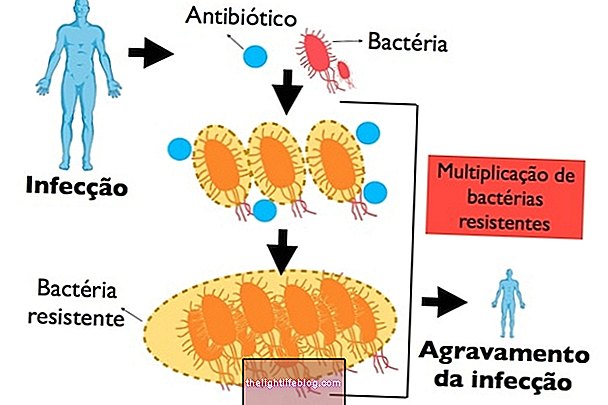The vaccines have the function of stimulating the immune system to produce antibodies, whose function is to protect the body from invasion by bacteria and viruses responsible for causing infectious diseases.
There are vaccines that are part of the national vaccination plan, which are administered free of charge, and others that can be administered by medical advice or if the person travels to places where there is a risk of contracting an infectious disease.

What are worth for
Vaccines are used to prevent diseases such as chicken pox, pertussis, dengue, diphtheria, meningococcal disease, pneumococcal disease, yellow fever, typhoid, influenza, Haemophilus type B meningitis, hepatitis A and B, HPV, poliomyelitis, rabies, gastroenteritis caused by Rotavirus, measles, tetanus and tuberculosis.
Most vaccines that prevent these diseases are part of the national vaccination plan and are free of charge.
How they work and what types
There are two types of vaccines, which have very weak or inactivated live infectious agents in their composition, and those that use dead agents, altered or only particles of the microorganism that causes the disease.
These vaccines are introduced into the body and their immune system acts against this agent, producing specific antibodies. If one day later the microorganism invades the organism, it already has the specific antibodies to combat it and prevent a disease from occurring.
National Vaccination Calendar 2018
There are several vaccines that are part of the national vaccination plan and can be administered free of charge:
1. Babies up to 9 months old
In infants up to 9 months, the vaccination plan is as follows:
| At birth | 2 months | 3 months | Four months | Five months | 6 months | 9 months | |
BGC Tuberculosis | Single dose | ||||||
| Hepatitis B | 1st dose | ||||||
Penta / DTP Diphtheria, tetanus, whooping cough, meningitis and poliomyelitis | 1st dose | 2nd dose | 3rd dose | ||||
|
VIP / VOP Polio | 1st Dose (with VIP) | 2nd Dose (with VIP) | 3rd Dose (with VIP) | ||||
Pneumo10 Pneumonia, meningitis and otitis | 1st dose | 2nd dose | |||||
Rotavirus Gastroenteritis | 1st dose | 2nd dose | |||||
MeningoC Meningococcal infection, including meningitis | 1st dose | 2nd dose | |||||
| Yellow fever | Single dose |
2. Children from 1 to 9 years old
In children between 1 and 9 years of age, the vaccination plan is as follows:
| 12 months | 15 months | 4 years | nine years old | |
Penta / DTP Diphtheria, tetanus, whooping cough, meningitis and poliomyelitis | 1st Reinforcement (with DTP) | 2nd Reinforcement (with OPV) | ||
VIP / VOP Polio | 1st Reinforcement (with OPV) | 2nd Reinforcement (with OPV) | ||
Pneumo 10 Pneumonia, meningitis and otitis | Reinforcement | |||
Meningo C Meningococcal infection, including meningitis | 1st Reinforcement | |||
Viral triple Measles, mumps, rubella | Single dose | |||
Viral Tetra Measles, mumps, rubella and chicken pox | Single dose | |||
| Varicella | Single dose | |||
| Hepatitis A | Single dose | |||
HPV Human papilloma virus | 2 doses (girls 9 to 14 years) |
3. Adults and children from 10 years old
In adolescents, adults, the elderly and pregnant, the vaccination plan is as follows:
| 10 to 19 years | Adults | Elderly (> 60 years) | Pregnant | |
| Hepatitis B | 3 doses | 3 doses | 3 doses | 3 doses |
|
Meningo C Meningococcal infection, including meningitis | 2nd Reinforcement (11 to 14 years) | |||
| Yellow fever | Single dose | Single dose | Single dose | |
Viral triple Measles, mumps, rubella | 2 Doses (up to 29 years) | 1 Dose (30 to 49 years) | ||
| Double adult | Reinforcement every 10 years | Reinforcement every 10 years | Reinforcement every 10 years | 2 Doses |
|
HPV Human papilloma virus | 2 doses (boys from 11 to 14 years) | |||
adult dTpa Diphtheria, tetanus and pertussis | Single dose |
Learn more about the triple viral and tetravalent vaccine.
Does vaccine protection last a lifetime?
In some cases, immune memory lasts a lifetime, but in others, it is necessary to boost the vaccine, as is the case of meningococcal disease, diphtheria or tetanus, for example.
It is also important to know that the vaccine takes some time to take effect and therefore, if the person is infected shortly after taking it, it may not be effective.
Most Common Vaccine Questions
Can vaccines be used in pregnancy?
Yes. As a risk group, pregnant women should take some vaccines, such as the influenza vaccine, hepatitis B, diphtheria, tetanus and pertussis, which are used to protect the pregnant woman and the baby. The administration of other vaccines should be evaluated on a case-by-case basis and prescribed by the physician.
Do vaccines cause fainting in some people?
No. Generally, people who faint after receiving a vaccine are due to the fear of the needle, because they feel pain and panic.
Can women who are breastfeeding take vaccines?
Yes. Vaccines can be given to infants in order to prevent the mother from transmitting viruses or bacteria to the baby. The only contraindicated vaccines for breastfeeding women are yellow fever and dengue fever. Learn more about the yellow fever and dengue vaccine.
Can you take more than one vaccine at a time?
Yes. The administration of more than one vaccine at the same time does not impair health.
What are combination vaccines?
They are vaccines that protect the person from more than one disease and where only one injection is required, as is the case of the triple viral, tetraviral or bacterial penta, for example.



























